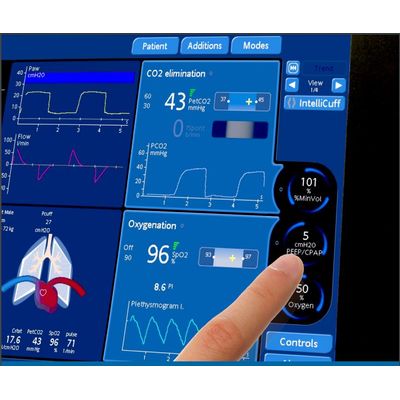

- Home
- Companies
- Hamilton Medical
- Products
- Intellivent - Model ASV - Intelligent ...

Intellivent - Model ASV - Intelligent Ventilation Mode
Intelligent ventilation mode for passive and spontaneously breathing adult and pediatric patients. Automatically controls ventilator settings based on the targets for ventilation and oxygenation set by the clinician and on physiologic input from the patient. Automatically applies lung-protective strategies. Provides an automated weaning protocol.
In conventional ventilation modes, the clinician sets ventilator controls such as tidal volume, respiratory rate, and expiratory and inspiratory time to achieve clinical targets, including a certain level of oxygenation and alveolar ventilation for the patient.
With INTELLiVENT-ASV, the clinician sets targets for PetCO2 and SpO2 for the patient. INTELLiVENT-ASV then automates the ventilator controls to reach these targets while at the same time taking into account the physiologic inputs from the patient (PetCO2, SpO2, lung mechanics, spontaneous breaths). It automatically sets controls relevant to oxygenation (PEEP, Oxygen) and ventilation (mandatory rate, inspiratory time, tidal volume, and inspiratory pressure).
INTELLiVENT-ASV automatically employs lung-protective strategies to minimize complications from AutoPEEP and volutrauma/barotrauma. It also prevents apnea, tachypnea, dead space ventilation, and excessively large breaths. Within the rules of this lung-protective strategy, INTELLiVENT-ASV encourages the patient to breathe spontaneously. It also provides an automated weaning protocol (Quick Wean).
Because of its unique characteristics, INTELLiVENT-ASV was classified as the best ventilation mode among all existing modes for providing safety and patient comfort, as well as for promoting weaning (Mireles-Cabodevila 2013).
Since its introduction in 2010, INTELLiVENT-ASV has already been the topic of several studies. In addition, Adaptive Support Ventilation® (ASV), one of the core controllers of INTELLiVENT-ASV, has been discussed in over 30 studies.
Studies show that INTELLiVENT-ASV:
- Is safe (Arnal 2012, Arnal 2013)
- Keeps patients in an optimal zone more often (Lellouche 2013)
- Automatically adapts to different lung conditions (Arnal 2013)
- Requires fewer interactions by clinicians (Beijers 2014)
The bibliography gives an overview of the results of the studies on INTELLiVENT-ASV and of some of the underlying principles.
In INTELLiVENT-ASV, the clinician`s most important inputs are the patient`s gender and height (to calculate ideal body weight), and the targets for PetCO2 and SpO2. INTELLiVENT-ASV then automatically selects ventilator settings, manages the transition from passive to spontaneous breathing ventilation, and provides an automated weaning protocol.
Tidal volume and respiratory rate are determined by the time-proven Adaptive Support Ventilation (ASV) algorithm, based on the least work of breathing.
Positive end-expiratory pressure (PEEP) and the fraction of inspired oxygen (FiO2) are adjusted according to saturation of oxygen in the blood (SpO2), measured by pulse oximetry using a finger or ear probe. The combination of PEEP and FiO2 is selected according to a table derived from ARDSnetwork publications (ARDSnet 2000, Brower 2004).
Target minute volume is adjusted according to exhaled partial pressure of end-tidal CO2 (PetCO2, measured by a mainstream sensor positioned at the Y-piece) in passive patients, and according to respiratory rate in spontaneously breathing patients.
The clinician selects the patient`s clinical condition (normal lungs, acute respiratory distress syndrome ARDS, chronic hypercapnia, or brain injury) to determine the appropriate default target ranges for PetCO2 and SpO2. These target ranges can always be manually adjusted based on clinical judgment.
Weaning with INTELLiVENT-ASV
INTELLiVENT-ASV provides an optional automated weaning protocol, Quick Wean. Quick Wean progressively decreases pressure support, screens for the readiness-to-wean criteria, and provides an operator configurable weaning protocol. Quick Wean also includes the option to automatically conduct fully controlled spontaneous breathing trials (SBT).
